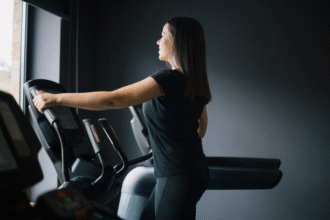What Is Peak Oxygen Uptake?
Peak oxygen uptake is the highest rate at which the body can take in, transport, and use oxygen during an incremental exercise test. It is measured directly with a cardiopulmonary exercise test that records breath‑by‑breath oxygen consumption and carbon‑dioxide production from rest through progressively higher workloads and into recovery. When a clear plateau in oxygen consumption occurs despite increasing workload, the term maximal oxygen uptake is used; many people—especially in clinical settings—do not demonstrate a strict plateau, so the highest value attained is reported as peak oxygen uptake. In practice, both reflect cardiorespiratory fitness and functional capacity and are widely considered the reference standard for assessing aerobic exercise ability.
Physiologically, peak oxygen uptake is governed by the integrated performance of the heart, lungs, blood, and working muscles. According to the Fick principle, oxygen consumption equals cardiac output multiplied by the difference between arterial and venous oxygen content. Cardiac output rises with heart rate and stroke volume to deliver oxygenated blood, the lungs oxygenate that blood and maintain adequate oxygen saturation, hemoglobin concentration determines how much oxygen can be carried, and skeletal muscle characteristics—capillary density, mitochondrial content and function, and enzymatic capacity—determine how effectively oxygen is extracted and used to generate energy. Test modality, motivation, and limiting symptoms can also influence the measured value.
Across the lifespan, values are highest in late adolescence to early adulthood and gradually decline with age due to changes in cardiac output, muscle mass, and peripheral oxidative capacity. On average, women have lower values than men when expressed per kilogram of body mass, largely due to differences in body size, hemoglobin concentration, and cardiac dimensions; expressing results relative to fat‑free mass narrows this gap. Genetics, habitual physical activity, and health conditions such as heart, lung, or metabolic disease meaningfully affect individual results.
Clinically and practically, peak oxygen uptake helps explain reduced exercise tolerance, distinguish cardiac from pulmonary or peripheral limitations when interpreted alongside other test indices, and guide rehabilitation and training. It has prognostic value in several cardiopulmonary disorders and provides an objective anchor for setting training intensities with reference to ventilatory thresholds. Because treadmill testing typically elicits slightly higher values than cycle ergometry in untrained individuals, comparisons should use the same mode when possible, and repeat measurements under similar conditions provide the most reliable trends.
Peak oxygen uptake can be improved through regular, progressive endurance training that challenges the cardiovascular and muscular systems while allowing adequate recovery. Approaches ranging from continuous moderate‑intensity work to carefully planned interval training can raise both central delivery and peripheral utilization capacities. Supporting factors—such as good technique, appropriate nutrition and hydration, sleep, management of anemia or other medical issues, and consistent training over time—help maximize gains. People with chronic conditions or recent illness should seek guidance from a clinician or qualified exercise professional to translate results into day‑to‑day training targets safely.







